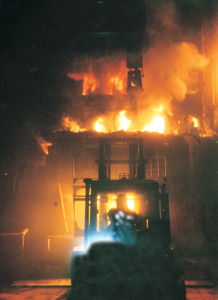MEN OF STEEL

The Waynedale News is printed at the Post and Mail in Columbia City. Every other Friday I would drive past SDI on the way to pick up the paper, and note the progress of the new steel mill. Groundbreaking was May 29th, 2001. Eleven months later the facility was melting and casting its first steel. It seemed to just materialize out of the ground, like a giant erector set.
Keith Busse, Mark Millett and Dick Teets, while working at Nucor Steel in Crawfordsville, IN, helped develop thin slab casting, the first new process in steel manufacturing in the last twenty or thirty years. In 1993 Steel Dynamics was born when they departed Nucor in order to pursue a dream of becoming a major player in the world of steel production.
In the 1920’s, Ayne Rand wrote a book called Atlas Shrugged. The book is a classic. It chronicles the struggles that occur as her leading man attempts to carve out a niche for himself in the steel industry. Busse, Millett, and Teets are men such as this. They have taken what was once just a dream and turned it into the most progressive profitable new steel company in the country. One, that on a level playing field, can compete with the Japanese, the Germans or any other steel producer. Currently SDI owns steel plants in Butler, Pittsboro, Jeffersonville, and Columbia City, Indiana. Their headquarters are located in Ft. Wayne. In ten years they have grown from a three-person company into one that now employs over 1000.
I traveled out to their Administration Building on a Monday morning and Dick Teets, Vice President and General Manager, met me. The first stop was at the incoming rail spur near massive piles of scrap metal. OmniSource of Fort Wayne is the major supplier of scrap steel to SDI. Anyone that believes in recycling would have to love these symbiotic operations. OmniSource feeds junk cars into their Fort Wayne shredder and the shredder gobbles up the old automobiles and feeds them onto a conveyor, where the ferrous (magnetic) product is separated from the non-ferrous. This is accomplished through a separation process using gravity and magnets. The shredded steel is then loaded onto train cars and shipped to SDI. If you have junked your old Chevy or Ford in the last few years, it may be occupying a spot in that rusty pile of steel you can see as you travel down US 30.
A mobile crane outfitted with a large magnet picks up the scrap steel and loads it into gondola cars for delivery to the melt shop where it is melted into molten steel. The melting process involves inserting electric probes into the scrap steel and creating a short circuit. If you’ve ever seen sparks fly when a worn electrical cord gets its wires crossed, then you’ve witnessed an event similar to what happens in SDI’s melt shop.
When the power is applied, you get some very dynamic results. The melt shop was in the middle of a melt when Dick and I arrived. There was a lot of loud popping and cracking, and a distinctive low volume hum of tremendous amounts of electrical energy being consumed. You could feel the energy all around as well as feeling the radiant heat emitting from the molten steel. The mill-hands were all working together to control slag run off and add the proper amounts of dolimitic lime and carbon. The 120-ton AC eccentric bottom tapping arc furnaces are fed by 120-MVA transformers and have an annual capacity of 1.2 million tons.
After a brief visit to a ladle refining station, the molten steel is then carried in large ladles, via an overhead crane, to the continuous casting area. The steel is funneled into the molds that shape the molten metal into three long continuous dog-bone shaped beam blanks. The beam-blanks are cut to the desired length, tagged with a unique identity and conveyed to the cooling area for storage. These semi-finished blanks will be further shaped into finished product in the rolling mill.
The rolling mill forces the unfinished blanks into grooves in steel rolls, shaping and conditioning the steel into desired shapes. The blanks are first reheated to 2200 degrees F and then transported to the first rolling mill stand. As it passes back and forth in a reversing motion, it begins to take the shape of an I-beam while growing in length. Then it moves to a three-stand tandem mill for the shaping required to get it to the customer’s required final dimensions. What started as a 40-foot long beam blank has become a 440-foot finished product. It is then cooled, cut to the proper length, and packaged for shipment.
Steel Dynamics will soon add railroad rail-making capacity to the plant. Instead of your old automobile being converted into an I-beam to support the super-structure of a new building it will also be providing rails for the shipping of its own products and others to markets across America.
- Celebrating 20 Years Of Community At The Stand - April 12, 2024
- First Positive Case Of Chronic Wasting Disease In Indiana - April 12, 2024
- Southwest Allen County Schools Embark On Major Tree Plantings - April 12, 2024


